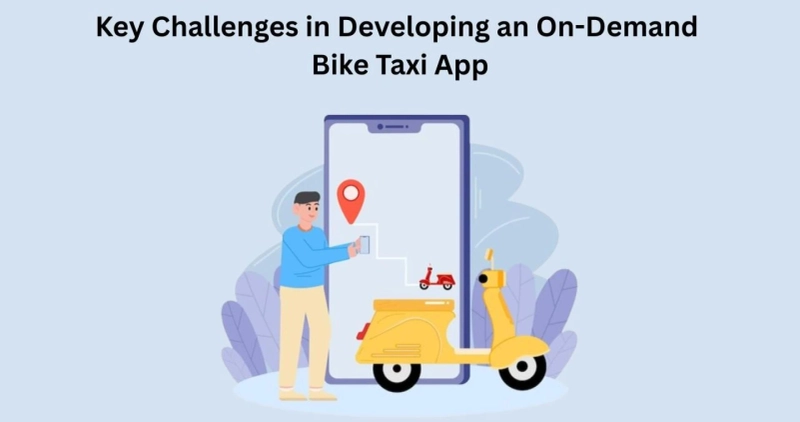The bike taxi industry has seen significant growth in recent years. With urban areas becoming more congested, on-demand bike taxi apps offer a practical solution for fast, affordable, and eco-friendly transportation. However, developing a successful bike taxi app comes with its own set of challenges. For entrepreneurs aiming to enter this space, understanding these hurdles is key to building a scalable and reliable platform. In this blog, we’ll explore the major challenges in developing an on-demand bike taxi app and how to overcome them.
1. Ensuring Scalability
One of the biggest challenges in developing an on-demand bike taxi app is ensuring it can scale effectively. As your user base grows, your app must be able to handle increased traffic, more ride requests, and more drivers without compromising performance.
Solutions:
- Cloud infrastructure: Use cloud-based platforms like AWS or Google Cloud to handle growing data and user load.
- Microservices architecture: Break down your app into smaller, independent components for better manageability and scalability.
- Load balancing: Distribute traffic across multiple servers to prevent slowdowns or crashes during peak times.
Building an app that can scale will ensure your business can handle growth and remain competitive.
2. Managing Real-Time Data and GPS Integration
One of the core features of an on-demand bike taxi app is real-time tracking. Riders need to know the location of available bikes, and drivers must receive ride requests with accurate navigation details. Handling this real-time data, especially in large cities with high user demand, can be a technical challenge.
Solutions:
- Reliable GPS tracking: Use Google Maps or Mapbox for precise and reliable GPS integration.
- Data synchronization: Ensure your backend can handle real-time data and sync seamlessly between riders and drivers.
- Optimized routing: Implement route optimization algorithms to suggest the fastest and most efficient routes for riders.
Managing real-time data effectively ensures that your app offers a smooth, real-time experience for both users and drivers.
3. User Experience (UX) and Interface Design
An intuitive and easy-to-use interface is critical to attracting and retaining users. Riders and drivers should be able to navigate the app effortlessly. Poor UX can lead to frustration, uninstalls, and negative reviews.
Solutions:
- User-centric design: Prioritize simplicity and ease of use. Use large, clear buttons, easy-to-follow steps, and intuitive navigation.
- App testing: Regularly test the app on different devices to ensure it works flawlessly across platforms.
- Feedback loops: Allow users and drivers to provide feedback on their experience, which can help you improve the app over time.
By focusing on a seamless UX/UI, you can ensure that your app remains user-friendly and competitive in the marketplace.
4. Driver Onboarding and Retention
Building a strong network of reliable drivers is essential for the success of your on-demand bike taxi app. However, driver recruitment and retention can be a challenge, especially in competitive markets.
Solutions:
- Easy onboarding process: Make the registration process simple and quick. Offer clear guidelines on bike maintenance, safety, and platform use.
- Incentives and rewards: Offer bonuses for completing a set number of rides, high ratings, or working during peak hours.
- Driver support: Provide 24/7 driver support to help with issues and improve their experience on the platform.
Ensuring that drivers are well-supported and motivated will help maintain a loyal and productive network.
Read More: Rapido Business Model: How Rapido Harnesses the Power of Motorbikes
5. Pricing and Payment Systems
Setting the right price for rides is a balancing act. Too high, and users will be discouraged; too low, and your business won’t be sustainable. Additionally, integrating a secure and easy-to-use payment system is crucial for both riders and drivers.
Solutions:
- Dynamic pricing: Implement surge pricing during high-demand periods while offering affordable rates during low-demand times.
- Multiple payment methods: Support various payment options, including credit/debit cards, wallets, and digital payment methods like PayPal and Stripe.
- Transparent pricing: Ensure riders know the fare before booking, and that drivers understand their earnings clearly.
A fair, transparent pricing model and seamless payment process can increase both customer satisfaction and driver retention.

6. Legal and Regulatory Compliance
Different cities have varying regulations regarding ride-hailing services, especially when it comes to bike taxis. Compliance with local laws is essential to avoid fines, lawsuits, and business shutdowns.
Solutions:
- Research local laws: Before launching in any city, research the local regulations regarding licensing, insurance, and transportation rules.
- Consult legal experts: Partner with legal advisors to ensure that your app adheres to the required standards and regulations.
- User and driver agreements: Draft clear terms of service and agreements for both users and drivers to prevent legal issues.
Staying ahead of legal requirements helps you avoid future complications and maintain a trustworthy platform.
7. Safety and Security
Ensuring the safety and security of both riders and drivers is paramount. With concerns around accidents, theft, and fraud, your app must include features that prioritize safety for all parties involved.
Solutions:
- Driver background checks: Implement background checks to ensure only qualified and trustworthy drivers are allowed to operate.
- In-app safety features: Include an emergency button for riders and drivers to quickly alert authorities if needed.
- Insurance coverage: Offer comprehensive insurance to cover both riders and drivers in case of accidents or injuries.
By making safety a priority, you can build trust with users and ensure a secure environment for both parties.
Conclusion
Developing an on-demand bike taxi app comes with several challenges, including scalability, real-time data management, user experience, driver retention, pricing, legal compliance, and safety. However, with careful planning and strategic solutions, these challenges can be overcome.
By partnering with professionals who offer on demand app development services, you can ensure that your app is built with the right architecture, features, and performance to succeed in the competitive ride-hailing market. With the right approach, your bike taxi app can provide a valuable service, grow your business, and make a positive impact on urban mobility.



